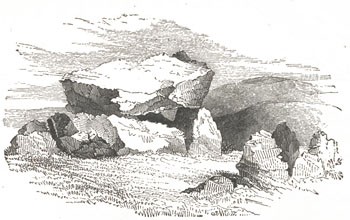Milesians in Ireland

Cromlech at Dunmore
Landing of the Milesians—Traditions of the Tuatha De Dananns in St. Patrick's time—The Lia Fail, or Stone of Destiny—The Milesians go back to sea "nine waves "—They conquer ultimately—Reign of Eremon—Landing of the Picts—Bede's Account of Ireland—Fame of its Fish and Goats—Difficulties of Irish Chronology—Importance and Authenticity of Irish Pedigrees—Qualifications of an Ollamh—Milesian Genealogies—Historical Value of Pedigrees—National Feelings should be respected—Historic Tales—Poems.
[A.M. 3500.]

HE last colonization of Ireland is thus related in the Annals of the Four Masters: "The age of the world 3500. The fleet of the sons of Milidh came to Ireland at the end of this year, to take it from the Tuatha Dé Dananns, and they fought the battle of Sliabh Mis with them on the third day after landing. In this battle fell Scota, the daughter of Pharaoh, wife of Milidh; and the grave of Scota [3] is [to be seen] between Sliabh Mis and the sea. Therein also fell Fas, the wife of Un, son of Uige, from whom is [named] Gleann Faisi. After this the sons of Milidh fought a battle at Taillten [4] against the three kings of the Tuatha Dé Dananns, MacCuill, MacCeacht, and MacGriéné. The battle lasted for a long time, until MacCeacht fell by Eiremhon, MacCuill by Eimheur, and MacGriéné by Amhergen."[5] Thus the Tuatha Dé Danann dynasty passed away, but not without leaving many a quaint legend of magic and mystery, and many an impress of its more than ordinary skill in such arts as were then indications of national superiority. The real names of the last chiefs of this line, are said to have been respectively Ethur, Cethur, and Fethur. The first was called MacCuill, because he worshipped the hazel-tree, and, more probably, because he was devoted to some branch of literature which it symbolized; the second MacCeacht, because he worshipped the plough, i.e., was devoted to agriculture; and the third obtained his appellation of MacGriene because he worshipped the sun.
Notes
[3] Scota.—The grave is still pointed out in the valley of Gleann Scoithin, county Kerry.
[4] Taillten —Now Telltown, county Meath.
[5] Amhergen.—Annals of the Four Masters, vol. i. p. 25.
